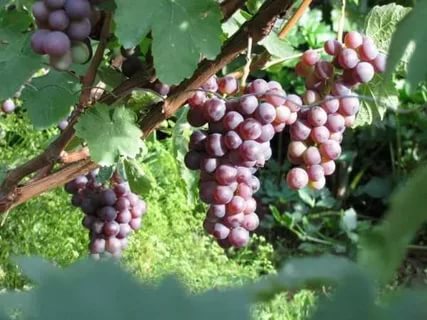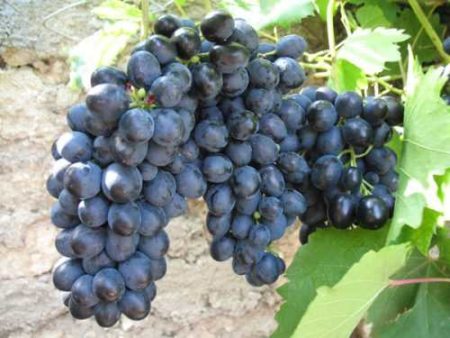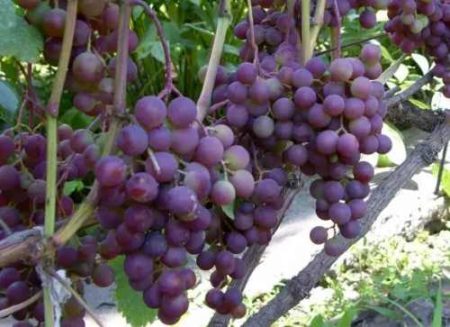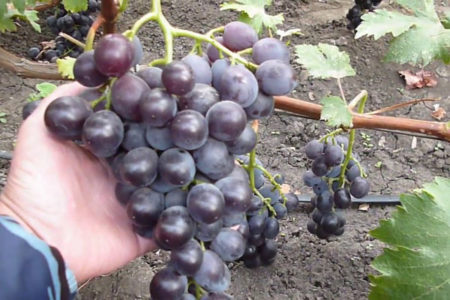In temperate climates, only early grape varieties mature. Early Russian is just that. Grade Author ME AND. Potapenko, breeding work was carried out in Novocherkassk. The genetic material was used - Northern Chasla, Michurinets. Early Russian is grown in Siberia, the Urals, the Far East. It is popular with winegrowers in the Northwest regions and in the center of Russia.
Content
Description
 Table variety, early ripening (80-100 days). With proper agricultural technology, the crop ripens in late July. The bush in the early Russian is vigorous. It is good to plant it next to the gazebos. Productivity is gaining slowly, the first 3 years the fruiting is weak. In the future, 20-30 kg of berries are collected from each bush.
Table variety, early ripening (80-100 days). With proper agricultural technology, the crop ripens in late July. The bush in the early Russian is vigorous. It is good to plant it next to the gazebos. Productivity is gaining slowly, the first 3 years the fruiting is weak. In the future, 20-30 kg of berries are collected from each bush.
Characteristics of the bush:
- strong vine;
- powerful root;
- bush width up to 5 meters.
The shoots are covered with oval or heart-shaped leaves of a deep dark green color with a mild dissection. Below they are covered with a slight pubescence, the color of the veins is lighter than that of a leaf plate. On one branch, 2-3 clusters can form.
The mass of the brush and the size of the berries depend on the agricultural background. When leaving the middle level, the brushes weigh about 400 g, if the care is good - the maximum weight is 600 g. Their shape is conical, they are quite loose. The length of the medium-sized brush reaches 25-35 cm.
Berries store sugar well. There is no acid in the taste of ripe fruit. Pulp composition:
- sugar - 22%;
- acid - 7 g / l.
The ripe fruit is dark pink, round. The dense skin is covered with a wax coating of a bluish tint. The weight of one berry can vary from 6 to 10 g. Weight depends on the quality of grape care. The taste of pulp is harmonious.
Harvest can be stored for no more than 3 months in a refrigerator or in a room with low temperatures and a stable level of humidity. Berries during transportation are damaged little, salable condition.
Direction of use
 The main purpose of growing Russian early is the market. The early variety diverges well in the summer. Eating fruits is universal:
The main purpose of growing Russian early is the market. The early variety diverges well in the summer. Eating fruits is universal:
- eat fresh;
- crush juice;
- allowed to wine.
Drinks of different strengths have a seasoned taste, they contain notes of muscat.
Advantages
All winegrowers emphasize the main advantage of early Russian - early maturity. Early ripening allows it to be grown in short summers. A big plus is integrated disease resistance. Bushes are rarely affected by gray rot, mildew, oidium.
Brushes without loss of commercial quality can be on the vine for a long time. During transportation, they retain their presentation. Grade productive, 2-3 brushes are formed on each fruitful shoot. Indicators of frost resistance are average. Bushes tolerate frosts up to - 23 ° C.
disadvantages
There are relatively few shortcomings, they all relate to fruits, there are three of them:
- small size;
- tendency to crack;
- hit by wasps.
Varietal features include a slow increase in yield in the first years after planting.
Planting and Care Rules

Grape growers with experience consider Russian early grapes the best material for beginners to study.
Saplings of this variety take root well, begin to bear fruit from the second year of life. The choice of place should be taken seriously, attention should be paid to the degree of coverage of the site and its size.
Adult, vigorous bush for life needs at least 5 m². This must be considered when landing. The bush can become a decoration of the garden, if it is planted on the south side of the gazebo, terrace.
Planting pits are dug with a depth of 50 cm, a width of at least 60 cm. A thick layer of gravel (20 cm) is laid on the bottom, it will improve the development of the root system and eliminate moisture stagnation. Before backfilling, it is necessary to add river, washed sand, humus, ash and superphosphate to the garden soil.
The main set of measures for the care of bushes grape:
- pruning
- watering;
- fertilizer application;
- row spacing, mulching;
- preparation for winter.
Starting from the second year, they begin to engage in pruning. Apply short and medium. On each fruiting shoot, 1-2 inflorescences are left.
Watering is carried out adjusted for soil, weather conditions. Particular attention is paid to him in the first year after planting a grape seedling. When carrying out watering work, a water consumption of 15 l / m² can be taken as a guideline.
Around the stem 2 times per season, you need to remove weed, shovel the upper layer of soil, pour a layer of mulch (peat, humus, rotted sawdust). In spring, grapes are fertilized with mineral fertilizers: potassium salt, ammonium nitrate, superphosphate.
Some gardeners prefer complex preparations: Novofer, Aquarin, Florovit. In summer, during the formation of a bunch, only fertilizers containing phosphorus and potassium are fed.
At the end of the season bushes fertilize one last time before the first severe frost. Experienced growers recommend covering the bushes with non-woven material during prolonged summer rains. This measure helps reduce crop losses from cracking berries and wasp damage.
Pests
Russian early plantations are rarely affected by ticks. The main pest is phylloxera. This is a species of aphid. The size of the insect is very small (0.25-2.25 mm), the color is yellow-green. Vineyards suffer from adults and larvae. The root type of phylloxera affects the underground part, the leaf form - aboveground.

In infected bushes, infected areas (seals) are cut, burned. The main way to deal with a pest is prevention. It consists of the following events:
- the use of healthy planting material;
- treat planting material with hexachlorocyclohexane (emulsion 24%);
- adding sand to the planting pit;
- aisle sow with parsley.
With a severe defeat, the bushes uproot, destroy. Soil is treated with chemical reagents. The site is kept in quarantine for at least 5 years.
Diseases
Subject to the rules of planting and care, the percentage of danger of mildew, gray rot, oidium is low. These diseases in Russian early are found only in case of gross violations of agricultural technology and when planting on wetlands.
Reviews
Alexey, Vinnytsia region
My early Russian bush is old; it was planted in 1883 on the south side of the house. For all this time he did not use chemistry, for the winter he did not harbor. The variety tends to overload, requires rationing of the crop. From a non-overloaded bush, we harvest at the end of July. I have relative care, but we collect 40-50 kg each year.
Vladimir, Krasnodar
For many years he grew up Russian early. He kept pace before everyone else. A few years ago I deleted it all. Much of it did not suit me. The clusters are not large, the berry is small. Bushes are prone to overload. The taste is very simple, the pulp is not dense, wasps again love its berries very much. All these minuses overcame the pros.In my opinion, there are two of them: early ripening, resistance to diseases.
Alexey, Zelenograd
The variety is unpretentious, I advise all beginners to gain experience on it. I have Russian early for 5 years. The brush and berries are small, but for our region are quite decent. I regularly feed phosphorus-potash fertilizers. The vine is ripening, the crops are not bad.
Conclusion
The Russian Early variety is an ideal choice for a beginner winegrower. It can be grown in the conditions of a short summer in the middle lane, it ripens in any weather, it accumulates sugar well. The taste of berries will delight any gourmet.




 Non-covering winter-hardy grape varieties for Moscow region
Non-covering winter-hardy grape varieties for Moscow region How to keep the vine in winter
How to keep the vine in winter When can I transfer grapes to another place in the fall
When can I transfer grapes to another place in the fall How to cover and prepare grapes for the winter in the suburbs
How to cover and prepare grapes for the winter in the suburbs